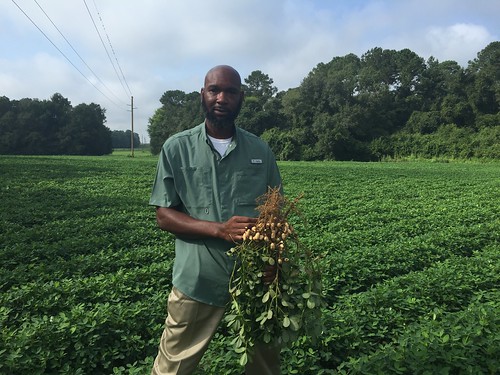
Veteran Tracy Robinson’s military experience counted toward farming experience, allowing him to access USDA microloan funding.
Graduating from high school in the small town of Blakely, Georgia, Tracy Robinson was required to take an armed forces aptitude test. When asked what he wanted to do with his life, Robinson said he wanted to farm. The Marine recruiter told him he would be a great field artilleryman.
“I heard the word field and thought it had something to do with farming,” said Robinson. He enlisted in the U.S. Marine Corps and after finding out field artillery had nothing to do with farming he stayed and fought for his country for 24 years, serving in Desert Shield, Afghanistan and Iraq.
He achieved the highest enlisted rank of E9 and traveled to 30 different countries before retiring in 2010 and returning to Georgia to do what he loves – farm.
Today, Robinson farms 300 acres of peanuts, cotton, soybeans and wheat, and he does it without owning or leasing any equipment. But to get to that point was a struggle and required a lot of support that many military veterans or underserved farmers once did not have.
Over the past eight years, however, the U.S. Department of Agriculture (USDA) has been turning that around, expanding the availability of its programs to more diverse farming communities, including veteran and women farmers. By forming partnerships and developing outreach efforts to restore trust and improve relationships, USDA has seen a 12 percent increase in black farmers and a 21 percent increase in Hispanic farmers.
The same efforts have been put into helping soldiers returning home who want to farm. Since 2009, USDA has provided $443 million in farm loans to help more than 6,505 veterans purchase farmland, buy equipment and make repairs and upgrades to farm businesses.
Robinson was one of those veterans who obtained a microloan in 2013 when, at the time, the Farm Service Agency (FSA) had just launched the $35,000 loan and shorter application process to help small and beginning farmers get started.
“Once I returned home from the military, I was able to rent the same land that my family rented farmed when I was a child,” said Robinson. “When I approached FSA in 2011 about a loan, they said I didn’t qualify because I had no farming experience.” He later ran into a high school friend who allowed him to volunteer and work on his farm to get the experience. “When the microloan came out, the criteria changed and my military experience counted toward my farming experience and I was approved.”
But the friendship and volunteering never stopped. Robinson still helps his friend while farming his own land; however, he enjoys the benefits because his friend allows him to use the farming equipment in return for Robinson’s help.
“Mr. Robinson is very successful primarily due to his discipline and attention to detail that can be attributed to his military experience. Also, his record keeping is unlike any other farmer that we work with,” said Rodney Brooks, former Farm Loan Officer with the Georgia FSA who helped Robinson at that time. “Without the microloan he would have had to struggle to fund his operation. Yet, Robinson insists that his situation is different from other veterans and underserved farmers.
“I do this because I enjoy farming and it is great mental and physical therapy for me,” said Robinson. “I had a lot of help. But a lot of military veterans return home to families and they don’t have the financial capital or access to get into farming.”
Robinson hopes to someday develop a program for veterans and young people, to not only teach them to farm, but teach leadership and life skills.
To learn more about how USDA is helping military veterans enter farming as a profession, visitwww.usda.gov/veterans and www.usda.gov/newfarmers. To learn more about FSA microloans, visitwww.fsa.usda.gov/microloans or contact your local FSA county office. You can find your nearest FSA office by visiting http://offices.usda.gov.
No comments:
Post a Comment
Note: Only a member of this blog may post a comment.